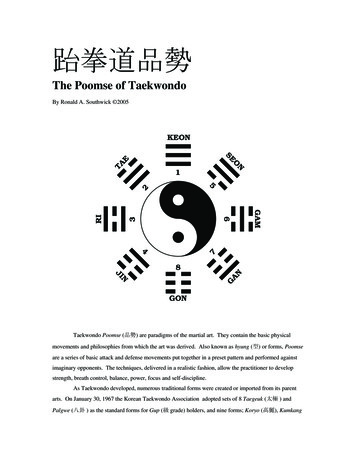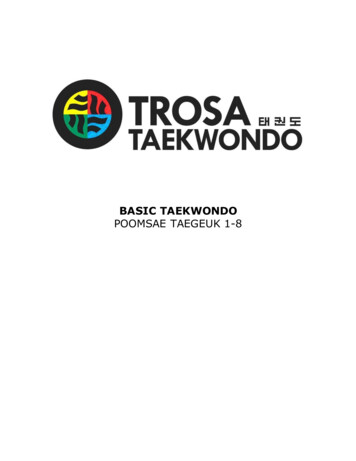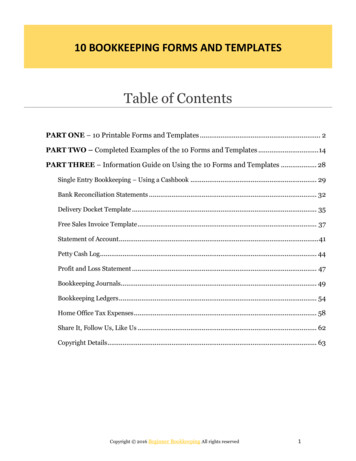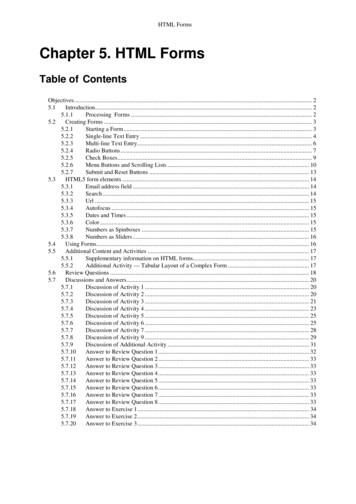
Transcription
跆拳道品勢The Poomse of TaekwondoBy Ronald A. Southwick 2005KEON25GAM36RINOTAESE174GNAJIN8GONTaekwondo Poomse (品勢) are paradigms of the martial art. They contain the basic physicalmovements and philosophies from which the art was derived. Also known as hyung (型) or forms, Poomseare a series of basic attack and defense movements put together in a preset pattern and performed againstimaginary opponents. The techniques, delivered in a realistic fashion, allow the practitioner to developstrength, breath control, balance, power, focus and self-discipline.As Taekwondo developed, numerous traditional forms were created or imported from its parentarts. On January 30, 1967 the Korean Taekwondo Association adopted sets of 8 Taegeuk (太極 ) andPalgwe (八卦 ) as the standard forms for Gup (級 grade) holders, and nine forms; Koryo (高麗), Kumkang
(金剛 ), Taebaek (太白 ), Pyongwon (平原 ), Sipjin (十進 ), Jitae (地跆 ), Chonkwon (天拳), Hansu(漢水) and Ilyo (一如 ) for Dan (段 degree) holders.Poomse serve as a Taekwondo encyclopedia. Each new form introduces new techniques, whichmust be mastered by the student to advance in rank and skill. When the movements and techniques fromall the Palgwe and Taegeuk forms have been learned, the individual is ready to become a Cho Dan (初段)or beginning black belt. The Yudanja (有段者) Poomse develop the practitioner’s skills into the Danlevels. Poomse do not necessarily teach us fighting, they show us the methods and behaviors to excel inmartial arts training.Poomse TheoryThe words Taegeuk and Palgwe essentially represent the same thing, the universe. Taegeukliterally translated means, “bigness” (Tae) and “eternity” (Geuk). Palgwe means, “The eight (Pal) trigrams(Gwe)”. They are derived from the I Ching, (易經) The Book of Changes. In the I Ching the universe isdivided into eight subsequent combinations of the major forces, um (陰) and yang (陽). Each combinationis represented by a symbol called a trigram, representing heaven, earth and man. Each trigram iscomprised of three lines, which can be broken – – (um or negative principle) or solid —– (yang orpositive principle). The number of possible combinations of a trigram consisting of three lines, broken orsolid is (23 8) eight; thus the eight universal principles the Taegeuk and Palgwe represent. The eighttrigrams are arranged in a circle around the symbol for um and yang. Each trigram is matched to a point onthe um/yang symbol according to the amount of negative and positive principle it contains. Due to thebalance inherent in the um/yang symbol, the resulting pattern represents the nature of the relationshipsbetween the trigrams; not as opposites, but as interdependent polarities that comprise the universe. Keon (乾) is the first trigram and represents the creative forces, heaven and light (天). Tae (兌)represents the concept of joy, often associated with a lake (澤). Ri (離) is the symbol of fire and clarity(火). Jin (震) is symbolized by arousing thunder (雷). Seon (巽), the gentle but powerful wind(風). Gam (坎), flowing water (水). Gan (艮) means stubborn and mountain (山). Finally, Gon (坤), the receptive earth (地). Together these concepts and symbols represent the balance of allnature. In Taekwondo training as well as in life we all hope to find balance. Each Poomse represents oneof the trigrams, and therefore part of the balance we hope to achieve. In this way, Poomse contain theintangible meaning behind the practice of Taekwondo.Executing the PoomseIn executing the Poomse, there are four elements that are considered; pattern, direction, stance,and technique.
The first element is the pattern of the form. Each Poomse has a pattern that the practitionerfollows during its execution. Traditionally these patterns were based on Chinese characters. In the figureabove the student stands at the beginning of the basic Taeguek pattern. At the end of the form the studentwill have moved along the black lines and returned to the starting position.The Taeguek Poomse all follow the pattern (王), which is based upon the trigrams. Execution oftechniques within the Taeguek form distinguishes the solid line —– (yang) or broken line – – (um). If thepractitioner takes a step forward on one of the horizontal lines of the pattern, the line is a solid (yang) line.If no step forward is completed it becomes a broken (um) line. The combination of these broken and solidlines creates the proper trigram pattern on the floor. In this way the basic movements and philosophicalbasis are preserved.Palgwe have some variation, 1-4 and 6 all use the pattern shape of the Chinese character, (工)gong, which means work. Palgwe 5 uses (干) gan, which means shield. In 7 and 8 the patterns are (下)ha, or below, and (土) tu, the earth, respectively.The Yudanja (有段者), Black Belt, Poomse all have a different pattern, based on a Chinesecharacter, and a philosophical meaning.Poomse / MeaningPatternCharacter DefinitionKoryo (Unified Korea)士 saScholar-GentlemanKumkang (Diamond Mountain)山 sanMountainTaebaek (Saint Mountain)工 gongWorkPyongwon (Fertile Plain)一 ilOneSipjin (Knowing Ten)十 sipTenJitae (Earth)上 shangAboveChonkwon (Sky)下 haBelowHansu (Water)水 suWaterIlyo (Oneness)卍 manAll Things
The Taeguek, Palgwe and Yudanja Poomse were developed from previous forms relatively recently, butclearly contain organized thought. The pattern retains the cultural link of language and also conveys thephilosophical message intended by the originator. To keep the message from being lost in time, thestudent must study and be diligent in their practice of Taekwondo.36912The second element is direction, which indicates the direction the student faces. In the figureabove the student is in the center of a clock. To the front of the student is twelve o'clock, back is sixo'clock, right is three o'clock and left is nine o'clock. This clock method is used when describing the formto convey direction. Practitioners of Palgwe and Taeguek forms are only required to face these fourdirections.Back Stance (Dwit Koobi) with Single Knife Hand Middle Block (Han Sonnal Momtong Makki)The third and fourth elements are related; they are the movements that make up the form. Stancerefers to the positioning of the feet and body. Technique denotes methods of blocking, striking, andkicking. Both of these elements are important because the stance and technique must be performed in theproper way to develop Taekwondo skill and preserve the continuity of the art.
Developing Poomse PerformanceThe practice and development of Poomse skill is the soul of Taekwondo practice. Poomse areused heavily in Taekwondo rank testing. A skilled instructor can discern the knowledge, skill level,strength, and focus of an individual just by watching them perform one form. When performing Poomseone must take into account several ideas:Technique – The Poomse is made up of Taekwondo techniques of blocking, striking and kicking. Withoutthe understanding and development of basic skills, Poomse cannot be performed properly. Blockingmotions should start and stop where they will be effective. Striking techniques should begin at the hip anduse the appropriate follow-through. Balance, control and proper foot positions should be used withkicking skills.Knowledge of the Poomse – It is important to learn as much as possible about the particular form. Thestudent should know the pattern, stances and techniques in as much detail as possible. Some of themotions in Poomse can appear to be very “abstract” and the practitioner must train hard to understand themotion. Knowing the history, Chinese character pattern and Palgwe idea inspires the student in practiceand adds enrichment to the experience.Attitude – To practice Taekwondo for any extended time takes perseverance and patience. These attributesare consciously developed in the course of training, and they comprise an important step in understandingthe art. Always foster a strong and determined attitude when Poomse training. Giving complete attentionto a task will create the proper mental idea to display in Taekwondo.Eye Focus and Precision – Since the Poomse is a “simulated combat” practitioners must look where theirimaginary opponent is located. Imagining an opponent will develop the precision of the attack and defensetechniques. Middle punches should strike the imaginary opponent’s chest, high blocks should redirect highpunches, and high kicks should hit the opponent’s face. Where the practitioner places these attack anddefense techniques depends on their ability to "see" the attacks and openings. This is the first step in theformation of precise and effective techniques.Posture and Balance – Posture and balance are really about controlling the center of gravity. Properposture, from a good stance, enables a practitioner to use maximum force. Balance allows us to controlthat force and to continue with the next technique quickly and efficiently.
Timing – Timing deals with the rhythm of the Poomse. One should perform the Poomse so that eachmotion is completed fully and then move on to the next without hesitation. This does not imply doing theactions in a rapid fashion but rather performing each motion properly.Power – The display of power is based on using tension and relaxation in body movements. In thepreparatory stage, relaxation is used. This helps to give speed to the technique. Once the technique hasbeen delivered as it approaches its action, tension is applied. Learning when and how to use these twoelements is one of the most important lessons of Poomse practice.Breathing and Kihop – Breathing is crucial to the development of Taekwondo skills. One should inhaleduring the preparatory motion and exhale on the delivery of the technique. The Kihop (氣合) or spiritshout, encompasses the idea that the exhalation is the strongest moment of the action. The Kihop shouldcome from the diaphragm and not the nose or throat.There is a great amount of historical, philosophical, physiological and practical information storedin Poomse. As Taekwondo practitioners we have a responsibility to remember this information andpractice it accordingly. Not only are we required to memorize the proper direction, pattern, stance andtechnique but also to display them with the proper balance and power in a consistent rhythm. The studyand performance of Poomse is an art form. The practitioner, in the performance of Poomse, encapsulatestheir skill, experience and understanding of Taekwondo and martial arts. To embody this takes hours ofpractice and can be a lifetime challenge of Taekwondo.
Taeguek 1 (Heaven)zAttention (Charyeut)z Bow (Kungye)z Ready stance (Joonbi)1. Pivot on the right foot turning toward 9 o'clock. Assume a leftwalking stance (Oen Apseogi). Execute a left down block (OenArae Makki).2. Advance toward 9 o'clock. Assume a right walking stance(Oreun Apseogi). Execute a right middle punch (Oreun MomtongBandae Chireugi).3. Turn clockwise toward 3 o'clock. Assume a right walking stance(Oreun Apseogi). Execute a right down block (Oreun AraeMakki).4. Advance toward 3 o'clock. Assume a left walking stance (OreunApseogi). Execute a left middle punch (Oen Momtong BandaeChireugi).5. Turn counterclockwise toward 12 o'clock. Assume a leftforward stance (Oen Apkoobi). Execute a left down block (OenArae Makki). Execute a right middle punch (Oreun Momtong BaroChireugi).6. With the left foot fixed, move the right foot to the left heel. Turntoward 3 o'clock. Assume a right walking stance (Oreun Apseogi).Execute a left outside-inside middle block (Oen Momtong AnMakki).7. Advance toward 3 o'clock. Assume a left walking stance (OenApseogi). Execute a right middle punch (Oreun Momtong BaroChireugi).8. Pivot on the ball of the right foot. Turn counterclockwise toward9 o'clock. Assume a left walking stance (Oen Apseogi). Execute aright outside-inside middle block (Oreun Momtong An Makki).9. Advance toward 9 o'clock. Assume a right walking stance(Oreun Apseogi). Execute a left middle punch (Oen MomtongBaro Chireugi).10. Turn toward 12 o'clock. Assume a right forward stance (OreunApkoobi). Execute a right down block (Oreun Arae Makki).Execute a left middle punch (Oen Momtong Baro Chireugi).11. Bring the left foot to the right heel. Turn toward 9 o'clock.Assume a left walking stance (Oen Apseogi). Execute a left upperblock (Oen Eolgool Makki).12. Execute a right front kick (Oreun Apchagi). Execute a rightmiddle punch (Oreun Momtong Bandae Chireugi) from a rightwalking stance (Oreun Apseogi).13. Turn clockwise toward 3 o'clock. Assume a right walkingstance (Oreun Apseogi). Execute a right upper block (OreunEolgool Makki)14. Execute a left front kick (Oen Apchagi). Assume a left walkingstance (Oen Apseogi). Execute a left middle punch (Oen MomtongBandae Chireugi).15. Pivoting on the right foot turn clockwise toward 6 o'clock.Assume a left forward stance (Oen Apkoobi). Execute a left downblock (Oen Arae Makki).16. Advance assuming a right forward stance (Oreun Apkoobi).Execute a right middle punch (Oreun Momtong Bandae Chireugi).Yell (Kihap).z Ready stance (Geuman) Pivot on right foot, turn body to the left.z Bow (Shiyo)
KEONTaegeuk Il Jang (1)13425165'7689101510'14'1413111212'
Palgwe 1z Attention (Charyeut)z Bow (Kungye)z Ready stance (Joonbi)16. Advance assuming a right forward stance (Oreun Apkoobi).Execute a right middle punch (Oreun Momtong Bandae Chireugi). Yell(Kihap).17. Turn counterclockwise toward 9 o'clock. Assume a left forwardstance (Oen Apkoobi). Execute a left down block (Oen Arae Makki).1. Turn toward 9 o'clock. Assume a left forward stance (Oen Apkoobi).Execute a left down block (Oen Arae Makki).18. Advance assuming a right forward stance (Oreun Apkoobi).Execute a right inside-outside middle block (Oreun Momtong BakatMakki).2. Advance assuming a right forward stance (Oreun Apkoobi). Executea right inside-outside middle block (Oreun Momtong Bakat Makki).19. Turn clockwise toward 3 o'clock. Assume a right forward stance(Oreun Apkoobi). Execute a right down block (Oreun Arae Makki).3. Turn clockwise toward 3 o'clock. Assume a right forward stance(Oreun Apkoobi). Execute a right down block (Oreun Arae Makki).20. Advance assuming a left forward stance (Oen Apkoobi). Execute aleft inside-outside middle block (Oen Momtong Bakat Makki).4. Advance assuming a left forward stance (Oen Apkoobi). Execute aleft inside-outside middle block (Oen Momtong Bakat Makki).z Ready stance (Geuman) Pivot on right foot, turn body to the left.z Bow (Shiyo)5. Turn counterclockwise toward 12 o'clock. Assume a left forwardstance (Oen Apkoobi). Execute a left down block (Oen Arae Makki).6. Advance toward 12 o'clock. Assume a left back stance (OenDwitkoobi). Execute a right inside-outside middle block (Oreun AnPalmok Momtong Yeop Bakat Makki).7. Advance assuming a right back stance (Oreun Dwitkoobi). Execute aleft inside-outside middle block. (Oen An Palmok Momtong YeopBakat Makki).8. Advance assuming a right forward stance (Oreun Apkoobi). Executea right middle punch (Oreun Momtong Bandae Chireugi). Yell(Kihap).9. Turn counterclockwise toward 3 o'clock pivoting on the right foot.Assume a right back stance (Oreun Dwitkoobi). Execute a left singleknife hand middle block (Oen Hansonnal Momtong Bakat Makki).10. Advance assuming a left back stance (Oen Dwitkoobi). Execute aright inside-outside middle block (Oreun An Palmok Momtong YeopBakat Makki).11. Turn clockwise toward 9 o'clock. Assume a left back stance (OenDwitkoobi). Execute a right single knife hand middle block (OreunHansonnal Momtong Bakat Makki).12. Advance assuming a right back stance (Oreun Dwitkoobi). Executea left inside outside middle block (Oen Momtong Yeop Bakat Makki).13. Turn toward 6 o'clock. Assume a left forward stance (OenApkoobi). Execute a left down block (Oen Arae Makki).14. Advance toward 6 o'clock. Assume a right forward stance (OreunApkoobi). Execute a right knife hand strike to the neck (OreunHansonnal Mok An Chigi).15. Advance assuming a left forward stance (Oen Apkoobi). Execute aleft knife hand strike to the neck (Oen Hansonnal Mok An Chigi).
Palgwe Il Jang (1)4, 203, 191, 172, 181651561471381091112
Taekwondo Poomse (品勢) are paradigms of the martial art. They contain the basic physical movements and philosophies from which the art was derived. Also known as hyung (型) or forms, Poomse are a series of basic attack and defense movemen










![[MS-OFBA]: Office Forms Based Authentication Protocol](/img/3/ms-ofba.jpg)